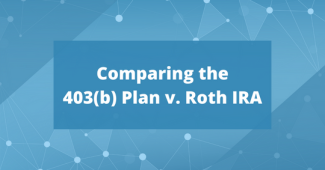
Compare a 403(b) with a Roth IRA
When deciding what types of retirement accounts you may need, it’s important to understand how your various options compare to each other. A few options you may have are 403(b) plans and Roth IRAs. It’s good to know how these two options compare and how you can contribute to each.
403(b)
A 403(b) plan is a retirement account designed for certain employees of public schools and other tax-exempt organizations. People eligible to use this type of plan may include teachers, school administrators, professors, government employees, nurses, doctors, and librarians.
This type of plan allows participants to save for retirement through payroll deductions in a tax-deferred account. Like other types of employer-sponsored retirement accounts, there is also the option for employers to match part of an employee’s contributions.
403(b) plans have a yearly monetary cap for how much a person can contribute. The current contributions limit is $20,500 for the 2022 tax year. This plan also offers a $6,500 catch-up contribution limit for those 50 and older who are looking to make up for a previous lack of contributions. Those participating in this type of retirement account must be 59 ½ before withdrawing their funds or face an early withdrawal penalty.
403(b) plans offer an advantage for those who have served 15 or more years with the same employer. This advantage allows employees to make catch-up contributions to their 403(b) plan, as much as an additional $3,000 per year, up to a lifetime limit of $15,000. And unlike other catch-up provisions, the employee doesn’t need to be 50 or older to take advantage of this.
While there are many advantages to 403(b) plans, there are some things to remember when deciding if it is right for you. 403(b) plans do have limited investment options, and some are not subject to Erisa. Also, you can expect to pay administrative fees that can be rather high.
Roth IRA
Roth IRAs are retirement accounts that do not need to be opened by an employer and are funded with after-tax dollars. However, you cannot take a tax deduction in the year of the contribution. When withdrawing from the account, you must be 59 1/2 and contribute at least 5 years or there are tax penalties.
Roth IRAs also do not have the advantage of employer-matching benefits. Because it is not an employer-sponsored account, all the money contributed to a Roth IRA is your own. In 2022, the contribution limit to a Roth IRA is $6,000, with catch-up contribution options of an additional $1,000 for those 50 or older. However, in a Roth IRA, there are no mandatory withdrawals and no maximum age for contributions limits.
Depending on your retirement savings situation, it could be beneficial to have both types of accounts and use them each to their full advantage, even if there are special rules concerning the contributions you make to each.
If you’d like more information about either of these retirement accounts, contact Team Treece at 305-751-8855.
– – –
Related Resources:
Annuities: Separating Fact from Fiction
How Caregivers Can Stabilize Their Financial Future
4 D’s That Can Derail Your Retirement
Longevity: An Underestimated Factor in Retirement Planning
– – –
All investing involves risk, including the possible loss of principal. There is no assurance that any investment strategy will be successful.
For a comprehensive review of your situation, always consult with a tax or legal advisor. Neither Cetera Advisors LLC nor any of its representatives may give legal or tax advice.
This material was developed and prepared by a third party for use by your Registered Representative. The opinions expressed and material provided are for general information and should not be considered a solicitation for the purchase or sale of any security. The content is developed from sources believed to be providing accurate information.
